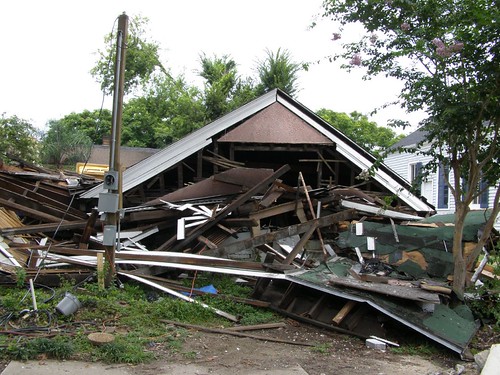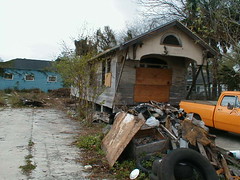
Architectural Salvage has been a long tradition in New Orleans architecture. Many buildings we see now are actually the second or third structure on the original site. The current structure having been built with materials from a more modest structure which occupied the lot previously. This can make determining the age of a building a bit tricky.
The true age of a building cannot always be nailed down to a specific year, rather, it is often a twenty-year span, or period. "Architectural forensics" is the examination which is required to really see the changes that have been made to a structure over time. It requires looking at every nook and cranny of a building; one finds that doors were closed up and additions added the back, fireplaces removed, galleries once open, closed for additional living and storage.
We saw what was uncovered when
this building was 'de-bricked' on Ursulines St. in this previous post regarding a Treme preservationist's forensic discovery.
To do this sort of evaluation, it is first necessary to understand the basic structures of New Orleans' homes. This book is a staple for any architecture buff in New Orleans.
New Orleans Houses: A House Watcher's Guide by Lloyd Vogt. Pelican Press, 1985.
Physical Risks of Salvage: Worst Case ScenariosThe structural demise of a building is usually due to multiple issues; neglect, natural disaster, unchecked termite damage. The post-collapse review of a building teaches us a lot about how buildings stand up as well as how they fall down. There are many buildings in the city right now which are various states of fragility due to demolition work or renovation work, both of which can cause a deadly collapse in a storm. This happened just this week in the case of the two story house at 2212 Marengo Street.

This house collapsed during a quickly developing afternoon storm which also produced lightning that caused another house in the immediate area to catch fire. The Marengo house which collapsed, was under salvage as part of a full demolition. The owner was making decisions as they worked regarding what might be saved and reincorporated into the new construction. However, the decision has now been made for them.
Basic surface salvage is sometimes called 'skimming' a house. Skimming removes inner details such as mantels, and also exterior details such as brackets and windows. In the case of Marengo, the goal was to take down and salvage as much as possible. This is much more involved than skimming. Unfortunately, the isolated afternoon storm torqued the house with a spiral wind. Thankfully, no one was hurt and none of the adjacent homes were damaged.
 Marengo Street House Before and AfterWorking Against Time
Marengo Street House Before and AfterWorking Against TimeJust as in construction, there are pivotal phases of demolition/renovation that are critical and must be worked through as fast as possible before weather threatens. Preventative bracing can be built if time permits.
The expert salvager working on Marengo St. has 20 years experience doing this in New Orleans. While working on the house, his team discovered that the house had a double layer roof. A regular shingled roof was applied over the top of an old slate roof. Slate roofs are great but they are very heavy. This was an additional factor working against this home in its fragile state.
The salvage team was very close to beginning the top-down process of hand demolition on this house. Usually, the windows and main features are removed, inner details such and decorative mantles and trim. Then the salvager begins taking down the structure in a methodical fashion beginning with the roof and working down and around the building. This method ensures that the the structure remains as stable as possible while hand demolition takes place. This is the same technique used in the hand demolition/salvage of the church on
Valence St. which I took many photos of as it was demolished without bulldozers in order to save the materials for the new structure.
 Architectural Poachers: The Dark Side of Salvage
Architectural Poachers: The Dark Side of SalvageThere are some people for whom architectural salvage is big business in New Orleans. These people pay for elements which have been stripped from homes throughout our Historic Districts by random people who walk in with brackets, cornices and other cypress trim pieces. They are culprits in stealing architectural elements when they accept and pay cash for items whose ownership and provenance cannot be proven by the seller. This is very much akin to poachers who poach nearly extinct animal species in the world's quickly dwindly jungles.
There was a recent case this when a man in the Treme area who had just bought a house on Kerelec St. M. had just begun a courageous renovation of this badly damaged home when someone
stole the milled headers off the windows on his house.
He sent out a plea for help to people in the preservation world who know the ropes. We pushed him to go to the various salvage stores and try to find the cornices that belonged to his house using photos he had as proof of ownership. He was successful when he got to the Bank, a known purchaser of items from architectural poachers. M. got his cornices back!

This problem has been rampant since Katrina because so many homes are left vacant and few neighbors are around to catch suspicious activity. It is also prevalent in our cemeteries and clients are often wealthy, elite scroungers from places like California.
 More Renovation Photos on Kerelec St. House
More Renovation Photos on Kerelec St. HouseThe widespread copper scrapping market deserves mention here because it has been devastating to homeowners since Katrina. This is
not salvage, this can happen to anyone, even if your house is fully operational and you are away at work. It has been black-market hell for homeowners in New Orleans for years and a scourge since Katrina. It is not reused as pipe, it is sold to molten into new product. I wrote about this on
Metroblogginglast year and it's still a problem, though, there has been a crackdown in District B.
Another new threat to our architectural heritage is the unscrupulous, selective poaching by contractors who are being paid to rebuild or renovate a home and put out bounties on a specific item they need for a particular job. Doors are particularly vulnerable and in some cases, entire blocks of houses have had their old doors stolen. Owners have had to resort to the installation of cheap, Home Depot doors which are not historically correct replacements but are stop-gap security measures. For homeowners who can't find or afford salvage materials, the
Home Depot-ficiation of our historic homes is a big preservation issue you will notice only if you take a stroll down our side streets in Mid-City.
What We Know: The Value of Individual ElementsThe unique cypress millwork detailing our homes is not something that can be recreated with same quality with modern material. An individual bracket can weigh 40 pounds. These pieces often survive the rest of a building's deterioration due to termites or water. When a building collapses, the millwork pieces often pop out with little damage. I found this to be the case with my own house's collapse as well as this instance at the Prytania St. demolition on Thanksgiving day, in which no formal salvage was even attempted of this 1920's structure which had some great Arts and Crafts elements worth saving.
The empty lot sits now, with a sign, pleading for lease. This demolition was done under the false premise of Katrina damages. It was in a non-flooded area surrounded by Touro Hospital, Uptown. Frankly, the owners were simply too lazy to fix the roof and get it back into commerce. The PRC agent who was there with me on Thanksgiving Day, a suspicious day for a demolition, discovered this after looking it up on Velocity.com.
It took two weeks to demolish this building, it could not have been in bad shape. After the building was gone for a week or so, a real estate sign appeared on the vacant lot. I called them. The agent cheerfully suggested someone could put a coffee shop there. I said, "You had a coffee shop there."

Something salvagers know is that the pine
flooring of New Orleans homes is often still salvageable after floods and collapse. It is in high demand as people remediate flood damage post-Katrina.
Bricks from entire masonry buildings can be reused. The bricks from fireplaces are commonly also reused. They are not only used in housing reconstruction, they are used in gardens and paved walkways.
Ironwork is reusable and very expensive to buy new. Fencing and railings can be reincorporated into new construction.
Windows with their casings are great elements to add to new construction because they add dimension to a facade and stained glasswork is particularly expensive to recreate but worth finding an artist to recreate for repair work on a mildly damaged old window.
Old doors are particularly beautiful with their detailed cypress millwork. These can run $800.00 each but are functional and add signature warmth to a house.
In the end, there is no dispute that new construction can be enhanced with original architectural elements. Remediation with salvage is arguable with your insurance company if you are in a National Historic District, most of us are. We cannot replicate the old materials/craftsmanship. Our unique building materials are finite resources. We live in a legacy. It is our responsibility to those before us to restore our homes as close as possible to their original character. We must think beyond the future but also to the past. We should follow the examples before us, using all the resources at our disposal. Once gone, they are gone forever.
Salvage Places in New Orleans: (websites are not available for all outlets)
NON PROFIT SALVAGE: Habitat RestoreThe Green ProjectFOR PROFIT SALVAGE: http://www.carrolltonlumber.com/architechturalsalvage.htmhttp://www.architectural-salvage.com/http://www.riccasarchitectural.com/http://www.humanitas-international.org/perez/clients/armadillo/index.htmlEducational Links:
Louisiana Studies in Historic Preservation


















